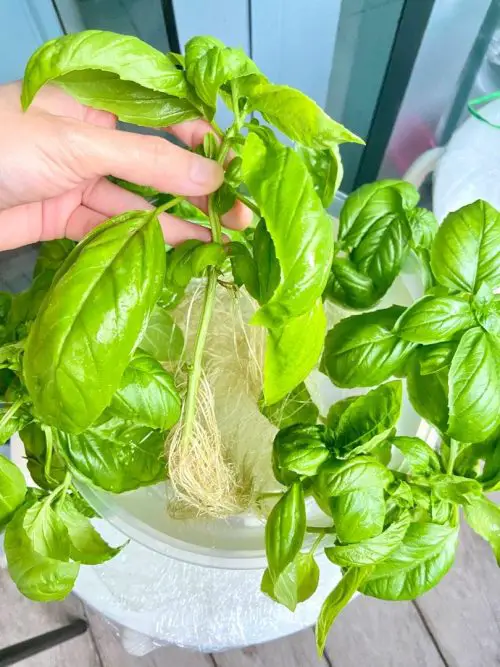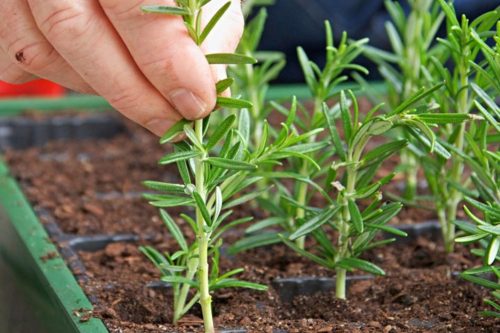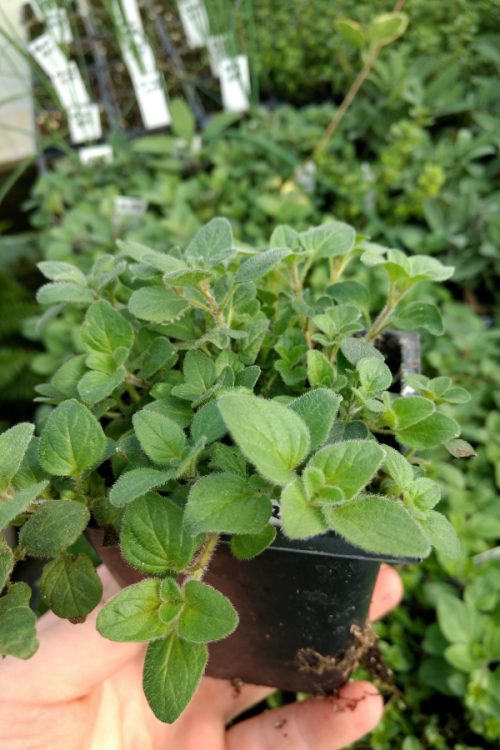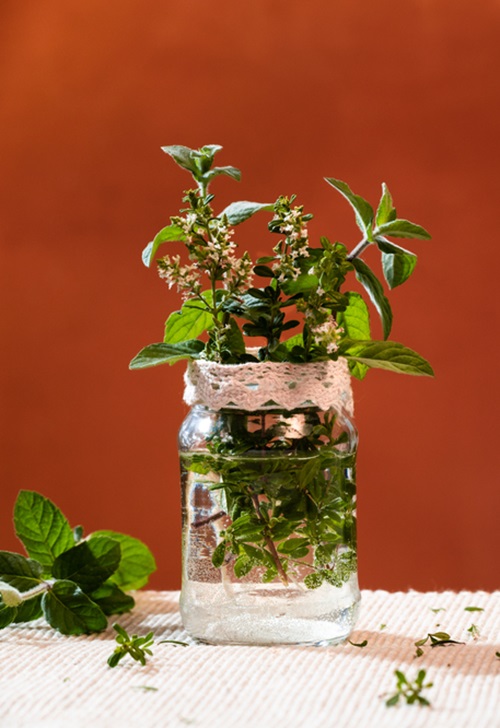We have handpicked the tastiest Indoor Herbs You Can Grow from Cuttings! Include them in your kitchen for the most flavorful cooking.
For this list, we selected herbs that can not only grow indoors but also have a reputation for growing easily from cuttings. So, you can plant them from your grocery store herb sprigs or pick several cuttings from outdoor plants to have them growing in the warmth of your home–aromatic herbs at your fingertips. If it sounds tasty, read on!
Check out herbs that grow best in small pots here
Growing These Herbs From Cuttings
1. Select a healthy, mature plant and snip a 4-6 inches long cutting. Remove the lower leaves, but save a couple of sets of top leaves to expose a bare stem in the bottom.
2. Dip the cut end in rooting hormone for better results, and plant it in a pot filled with well-draining soil mix.
3. Water moderately, ensuring the soil remains moist but not too overly moist, and place this pot in a warm spot with bright, indirect sunlight. Within a few weeks, your cutting shall root and begin new growth.
4. If you like, cover it with a cloche, some plastic film, or a dome to provide warmth. We have many similar ideas here to help you!
Note: You can also plant the cuttings in a glass of water, but growing them in the soil will produce more, and you’ll have a better quality and robust herb plant with more flavor!
5 Herbs You Should Never Keep in Fridge and Why?
Best Indoor Herbs to Grow from Cuttings
1. Basil: The Quintessential Contender!

An east, south, or west-facing window that offers some hours of direct sunlight is perfect. This location ensures your basil gets the vital sunlight it needs while adding a refreshing green touch to your kitchen.
Trim your basil’s top regularly to encourage bushier growth and prevent it from becoming leggy. Keep a pair of herb scissors nearby for convenience!
Culinary Uses:
- Italian Cuisine: Perfect for pasta, caprese salads, pesto, and fresh toppings on pizzas.
- Southeast Asian Dishes: Adds a fresh twist to Thai curries and Vietnamese pho if you’re growing a Thai Basil.
- Cocktails: A sprig of basil can transform a simple lemonade or a mojito.
Growing Basil Indoors Year Round | Basil Plant Care
2. Mint: The Refreshing Dude
To display your thriving mint in the kitchen, opt for a stylish, compact planter, you can even plant in a hanging basket.
Place it near a sunny window or provide it with filtered light; it won’t mind both. Keep it within your reach so that it’d be readily accessible for fresh flavor to your culinary creations! I personally like my mint in yogurt 🤤.
Culinary Uses:
- Salads: A key ingredient in tabbouleh and other fresh salads.
- Drinks: Essential for mojitos, mint juleps, and adding a twist to iced tea.
- Yogurt Dips: Perfect in tzatziki and other yogurt-based dips.
11 Fragrant Mint Varieties for Herb Garden
3. Rosemary: That Rustic Delight!

Once your rosemary cutting takes root, typically within a few weeks, you can transform your kitchen. Display your potted rosemary near a sunny window, where it thrives. The best thing about rosemary is it looks good too 😁.
Remember, rosemary thrives with good airflow and bright light, so choose a spot that caters to these needs.
Culinary Uses:
- Roasted Meats: A sprig of rosemary transforms roasted lamb, chicken, or beef.
- Breads: Infuse bread dough with chopped rosemary for a rustic flavor.
- Vegetables: Excellent for flavoring roasted or grilled vegetables. Overall, rosemary is versatile and can go in everything.
4. Thyme: Mr. Subtle Aroma
Position it near a well-lit window or keep it on a balcony to ensure it receives enough direct sun, which is crucial for its growth and flavor development. This placement meets its sunlight needs and adds a natural, lively element to your kitchen’s ambiance.
You can also create a small herb corner by pairing thyme with other kitchen favorites like rosemary and oregano. This maximizes your culinary options!
Culinary Uses:
- Soups and Stews: Adds depth to French onion soup and beef stew.
- Roasted Meats and Poultry: Enhances the flavor of chicken, turkey, and pork.
- Vegetarian Dishes: Complements mushrooms and eggplant beautifully.
10 Best Thyme Growing Tips | Growing Thyme in Containers
5. Oregano: The Mediterranean Taste

A pot of oregano with a unique design or vibrant color can be a nice focal point in your indoor plant collection. Ensure it has drainage holes to prevent water retention, which is crucial for oregano’s root health.
Place this herb conveniently on a sunny kitchen shelf or windowsill, ensuring it’s within easy reach during cooking. This practical placement allows you to add a sprinkle of fresh oregano to your dishes effortlessly.
Culinary Uses:
- Sauces: Essential in marinara and pizza sauce and much more.
- Greek Dishes: Perfect in Greek salads, grilled meats, and marinades.
- Mexican Cuisine: Adds a zesty flavor to tacos and enchiladas.
12 Magical Properties of Oregano That’ll Surprise You
6. Parsley: The Earthly Tones

If you like, accompany parsley with other herbs like chives or cilantro for a diverse kitchen herb garden. The best thing about parsley is once it is established, it never dies if you keep multiplying the mother plant on time by division.
You can position its pot where it is easily accessible during cooking activities, such as near the prep area on the kitchen island or alongside the stove – and the best, this herb can grow in the shade, so you can even grow it in indirect light but for the best growth ensure at least couple of hours of direct sun exposure.
- Salads: Fresh parsley adds a vibrant, peppery flavor to salads.
- Soups and Stews: Add it to soups and stews for an extra layer of flavor. It pairs well with a variety of vegetables and meats, too.
- Sauces and Dressings: Parsley forms the base of many sauces and dressings. For example, the classic Argentinean chimichurri sauce!
7 Different Types of Parsley Varieties
Why Growing from Cuttings Makes Culinary Sense
- Freshness: Nothing beats the taste of freshly snipped herbs in your cooking.
- Cost-Effective: Skip the weekly herb shopping; your indoor garden is a one-time investment for a continual supply.
- Healthy: Growing your own herbs means you’re in control, free from pesticides and chemicals often found in store-bought varieties.
Conclusion
Tossing some freshly plucked basil into your pasta or garnishing your mojito with home-grown mint is always good! By growing these herbs from cuttings, you’re not just cultivating plants; you’re cultivating flavors that transform your home cooking into a gourmet experience. So, why wait? Start your flavorful journey today!




